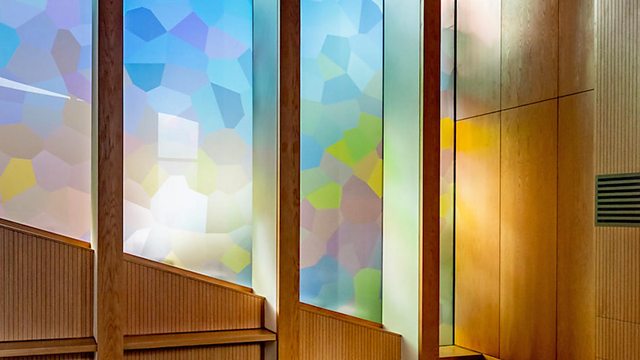
Art and Christianity 3: Oceanic Ray
The last of three services reflecting on contemporary works of art in churches in the UK.
The last of three services reflecting on contemporary works of art in churches in the UK. In this act of worship, from St Peter's Church, Battersea, Professor Ben Quash from King’s College London reflects on the church's new windows by the artist Ptolemy Mann, Oceanic Ray . The service is led by the Pastor, Rev Patrick Malone.
Music
1. Be thou my vision - Jeff Victor and Rebecca Arons
(CD: Amazing Grace Hymns Collection - Lifescapes)
2. Morning has broken - Katharine Jenkins
(CD: Guiding Light)
2. Lux Aurumque - Eric Whitacre
(CD: Light and Gold)
3. Here I am to worship - Tim Hughes
(CD: The World's Favourite Worship Songs)
Last on
More episodes
Previous
Oceanic Ray - Ptolemy Mann
‘Glory be to God for dappled things’, wrote the Victorian poet Gerard Manley Hopkins in his poem Pied Beauty. And he proceeded to list many of the dappled things that so delighted him, including ‘rose moles all in stipple upon trout that swim’.
The patterns of a fish’s scales can have an intense beauty, even a glory to them—iridescent and m
any-coloured. And that’s partly what gives beauty to this series of coloured windows created by the artist Ptolemy Mann. Using state-of-the-art techniques that allow the glass to be digitally printed, this is a very modern take on stained glass.
The church’s dedication to a fisherman who gave his life to Christ, Simon Peter, makes the choice of the scale-patterns symbolically appropriate. But the symbolism needn’t stop there. For Peter’s fellow apostle, Paul, came to faith as his sight was restored, and the effect of this transformation is described in Acts as having been like scales falling from his eyes.
The scales in these windows may not be about to vanish away, but they are made to admit light. They do not just reflect light back towards its source, as a fish’s scales do. Light irradiates them, and illuminates the interior of the church, giving different moods to different areas in the building, and sending out light to its urban surroundings after dark. The scales on Paul’s eyes made way for the light. These scales make a way for the light.
And at the risk of being fanciful, another fishy biblical association may come to mind here too. If the coloured scales in the windows are intended to envelop the building, as the artist has suggested, then to be in its interior is a bit like being inside a fish. Perhaps, then, we might find ourselves thinking about Jonah, as well as about Peter and Paul. Peter and Paul were both called to new lives in service of God, but so was Jonah, and it all began in the belly of the fish, when he lifted up his voice and praised God even though all seemed lost: ‘with the voice of thanksgiving, I will sacrifice to thee; […] Deliverance belongs to the Lord!’ (Jonah 2:9–10). There is room for a repentance like Jonah’s in this church. There’s also room for the liberation and mission that follows it.
One last fish. The sign of the fish could claim to be the earliest form that Christian art took. It was used to represent Christ, because the initial letters of the words ‘Jesus Christ, God’s Son, Saviour’ spelt out the word ichthus, or fish, in Greek.
Those who worship in the dappled—the ‘pied’—beauty of St Peter’s are embraced in the body of a very different fish from the one that swallowed Jonah: they are in Christ’s body, a body in which we are united with the patriarchs and prophets (even the reluctant ones!), with Paul, with Peter, with one another, and with God’s own life.
Broadcast
- Thu 28 Nov 2019 09:4591�ȱ� Radio 4 LW


